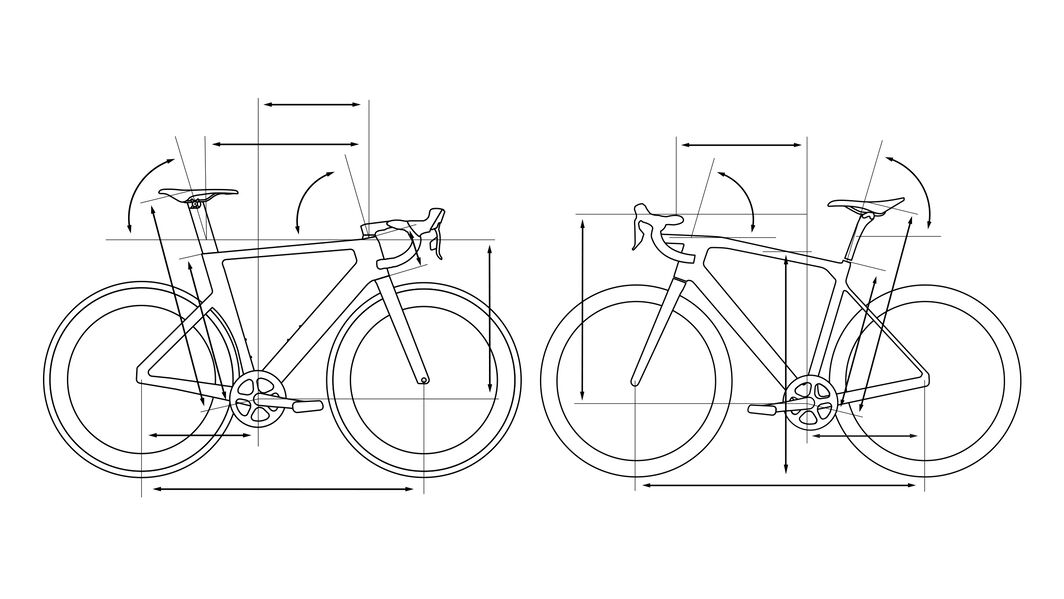Hybrid and gravel bikes offer flexibility for riders, though they serve varied preferences and environments. Below is an examination of the primary distinctions between these bicycle categories:
Hybrid Bike:
- Purpose: Hybrid bikes are designed for general-purpose riding, combining features of road bikes and mountain bikes to handle a variety of terrain, from pavement to light off-road trails. They are ideal for commuting, recreational riding, and fitness.
- Frame: Hybrid bike frames are typically made from aluminum or steel, and they have a more upright, relaxed geometry that promotes a comfortable riding position.
- Wheels and Tires: Hybrid bikes usually have 700c wheels (the same size as road bikes) with wider tires, ranging from 28mm to 45mm. The wider tires provide more stability and comfort on different surfaces but may be slower than narrower road bike tires.
- Gearing: Hybrids often have a wide range of gears, allowing for easier pedaling on hills and faster speeds on flat terrain. Many hybrid bikes feature a triple front chainring setup for maximum versatility.
- Brakes: Most hybrid bikes have either rim brakes or mechanical disc brakes, offering sufficient stopping power for casual riding and commuting.
- Handlebars: Hybrid bikes typically have flat or riser handlebars, which allow for an upright riding position and easy control.
- Accessories: Many hybrid bikes come with mounting points for fenders, racks, and other accessories, making them convenient for commuting and touring.
Gravel Bike:
- Purpose: Gravel bikes are designed for off-road riding on gravel, dirt roads, and rough terrain. They are well-suited for adventure riding, bikepacking, and off-road racing.
- Frame: Gravel bike frames are usually made from lightweight materials such as aluminum, carbon fiber, or titanium. The geometry is more aggressive than a hybrid bike, offering a balance between comfort and performance.
- Wheels and Tires: Gravel bikes often use 700c wheels with wider, knobbier tires, typically ranging from 35mm to 45mm. The wider, more aggressive tread provides better traction and stability on rough terrain.
- Gearing: Gravel bikes typically have a wide range of gears with a focus on lower gear ratios for tackling steep climbs and rough terrain. Many gravel bikes feature a single or double front chainring setup.
- Brakes: Gravel bikes usually come equipped with hydraulic disc brakes, offering excellent stopping power and modulation in all weather conditions.
- Handlebars: Gravel bikes use drop handlebars, similar to road bikes, providing multiple hand positions for long-distance comfort and aerodynamics.
- Accessories: Gravel bikes often have mounting points for bike packing gear, fenders, and racks, making them versatile for multi-day adventures and off-road touring.
In summary, choose a hybrid bike if you’re looking for a comfortable, versatile bike for casual riding, commuting, and occasional light off-road use. Opt for a gravel bike if you’re interested in more adventurous off-road riding, bike packing, or tackling rougher terrain with a performance-oriented bike.
| Feature | Hybrid Bike | Gravel Bike |
|---|---|---|
| Purpose | General-purpose, commuting, recreational use | Off-road riding, bikepacking, adventure |
| Frame | Aluminum or steel, upright geometry | Off-road riding, bike packing, adventure |
| Wheels and Tires | 700c wheels, 28-45mm wide tires | 700c wheels, 35-45mm wide, knobby tires |
| Gearing | Wide range, triple front chainring | Wide range, single or double front chainring |
| Brakes | Rim or mechanical disc brakes | Hydraulic disc brakes |
| Handlebars | Flat or riser handlebars | Drop handlebars |
| Accessories | Mounting points for fenders, racks, etc. | Aluminum, carbon, or titanium, an aggressive geometry |

When deciding between gravel and hybrid bikes, you’ll need to weigh many factors, including price and gear range. Some pros of gravel bikes include wider range of gears, better traction on roots and rocks, and drop bars. However, there are some cons to gravel bikes, as well. In this article, we will compare the benefits of each type of bike and how they differ from each other.
Drop Bar Gravel Bikes
Gravel riding involves long, arduous rides, so choosing the right bike is vital. While many hybrid and road bikes have flat bars, gravel bikes can be designed with drop bars. Drop bars allow the rider to lower the handlebars and reduce the wind’s effects on the face. For this reason, choosing the right handlebar for your needs can help you maximize the comfort and performance of your bike.
A gravel bike features a wide range of gears. The name gravel bike suggests a wider range of gears than a hybrid, but the two bikes are actually very different. A gravel bike is designed for longer, rugged riding over rough terrain, while a hybrid is better suited for short commutes on paved surfaces. Hybrid bikes are also lighter than gravel bikes but lack the carrying capacity of gravel bikes.
For more information, check out the Specialized XC 105 hybrid. This bike has a Shimano 105 2×11 drivetrain, a full carbon frame, fender mounts, and a 20mm Future Shock. It also features an excellent range of gears and a durable through axle dropout. In terms of riding comfort, the Quick hybrid offers the best of both worlds.
While drop-bar gravel bikes tend to be more comfortable and ergonomically designed for long rides, a flat-bar hybrid may be the better choice if you’re taller, older, or live in a city with poor pavement. It is also easier to reach the gears and brakes with the flat-bar version. For longer rides, drop-bar gravel bikes can be more comfortable, as they can be adjusted for an ergonomic grip.
In addition to the seating position, drop-bar gravel bikes are more aerodynamic than a hybrid bike. Although drop-bar gravel bikes are not as comfortable as a hybrid, they are better for long trips in rough terrain. For those interested in competitive riding, a gravel bike is designed with drop bars. Hybrid bikes are more suited for commuting and are designed for casual riding. These bikes are also built for long-distance off-road touring.
Wider Range of Gears
When comparing a hybrid bike versus a gravel bike, it’s important to consider the gear range. A gravel bike has fewer gears, while a hybrid has a higher gear range. You won’t need as many low gears if you’re riding on flat terrain. If you don’t plan on carrying heavier loads, a smaller range of gears may be enough. The difference in weight and maintenance is minimal.
While hybrid bikes have a straightforward gearing system, a gravel bike has more gears and is more expensive than its counterpart. Although both bikes have similar features, gravel bikes are designed for off-roading and have larger gear ranges. Hybrid bikes are lightweight and often have a limited carrying capacity, while gravel bikes are built for long-distance touring. Their frames are robust enough to carry luggage.
In addition to being lighter, gravel bikes are also easier to maneuver. The narrower frame and relaxed geometry make gravel bikes ideal for bicycle touring and riding for hours on end. Gravel bikes with MTB DNA are often referred to as adventure bikes. They can be converted back to a road bike with a simple tire swap. If you’re considering a gravel bike, you’ll want to make sure it can accommodate your desired travel style.
As gravel bikes are intended to be versatile, choosing a hybrid bike with a single-chainring drivetrain can be difficult. For example, a gravel bike should be lightweight, durable, and comfortable, but also have wide gears for climbing steep slopes. Until recently, this was a common misconception. However, SRAM blew up this perception by introducing narrow-wide chainrings, which are common on gravel bikes, cyclocross bikes, and MTBs.
In comparison to a gravel grinder, a hybrid is often built with a drop handlebar. Drop handlebars make it easier for cyclists to control and steer, which are important considerations when riding on gravel. A gravel grinder also has more stability, which is important when riding on difficult terrain. A hybrid can be converted to a gravel bike, but the conversion process can be expensive.
Better Traction on Rocks and Roots
A hybrid bike has a wide range of gears and a wider tire, which makes it easier to handle off-road terrain. But you can’t expect the bike to handle frequent rocks and roots. If you want to ride off-road on a hybrid, you’ll have to lower the tire pressure to get the right amount of traction. You can’t expect it to smooth out bumps taller than two inches. And since hybrids don’t have suspension, they won’t smooth out any rocks and roots that are taller than two inches.
The best hybrid bikes are designed for city use, but they can handle limited off-road riding. You’ll be able to ride them on milder trails, but mountain bikes are more capable of tackling steeper terrain. They also come with lots of mounts for essential city accessories, including helmets and lights. But hybrids rarely have cutting-edge standards. They also don’t use proprietary parts.
A hybrid bike has wider tires than stock. However, keep in mind that the tires on hybrids are not interchangeable with road bike tires. A hybrid bike with a wider tire has more grip on rocky terrain. If you’re riding on a trail, you’ll need to wear a special type of tire with a wide tread. A flat-bar hybrid bike will give you better control.
More Expensive
When it comes to choosing the best bike, there are several options to consider. Gravel bikes are designed for rough terrain, with wider tires and more rigid frames. Hybrid bikes are the best choice for city cycling, while gravel bikes are more suited to off-road environments. Both bikes are similar in price and design, so you can choose which is more suitable for your needs. These bikes are a happy medium between road and mountain biking, and are equally suitable for a variety of riding conditions.
While gravel bikes are built to last for miles, they also provide a more comfortable ride. While hybrids can handle off-road surfaces, gravel bikes are best suited for commuting and longer rides. Both bikes are made with an upright riding position, and this design can either make the hybrid or gravel bike better or worse. A gravel bike can be a great option for commuting and shorter journeys.
Depending on the terrain you’ll be riding, gravel bikes are more comfortable to ride on because of their upright seating positions and wide handlebars. The only difference between gravel and hybrid bikes is their weight. Gravel bikes are heavier than hybrids, but they are also more durable and stable on any surface. For the most part, hybrid bikes cost less than gravel bikes. If you’re looking for an off-road bike for touring, you’ll probably prefer a gravel bike.
Another difference between gravel and hybrid bikes is their geometry. While cyclocross bikes are better for racing, hybrids are better for city riding and mild obstacles. If you plan on riding on mountain trails and in the city, a hybrid will serve you well. A cross bike is better for racing on different surfaces, but it’s also more expensive. If you want to use the bike for cyclocross or road racing, a cross bike is the best choice.
The first thing to keep in mind is the geometry. Many of the gravel bikes cost around $500, while a high-end model costs over two grand. However, the wheels of the cheaper bikes are not as durable as those of the more expensive bikes. In addition, the spoke count on gravel bikes is higher than those of hybrids, which is essential if you’re planning to carry panniers or other items.










